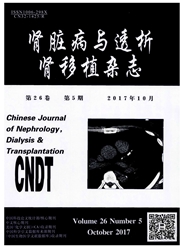

 中文摘要:
中文摘要:
转录组学是从RNA水平研究基因表达情况的学科.目前用于转录组数据获得和分析的方法主要有基于杂交技术的生物芯片技术和基于测序的RNA测序技术,这些方法的出现使得对细胞、组织表达谱的高通量分析成为可能,通过这些方法可以获得许多与疾病相关信息.原发性局灶节段性肾小球硬化(FSGS)是导致成人及儿童激素抵抗肾病综合征和肾衰竭的最常见原因之一,其病理生理机制至今仍不清楚.因此,有必要对其发病机制进行深入研究.近年来,数项FSGS的转录组学研究结果相继发表,进一步了解FSGS的致病机制提供了重要信息,本文就其在FSGS中的发现做一综述.
 英文摘要:
英文摘要:
Transcriptomics is an approach to study gene expression change based on RNA level. Currently, there are mainly two technologies used for collecting and analyzing transcriptomic data, i,e., microarray that is based on nucleic acid molecular hybridization, and RNA sequencing (RNA-Seq) based on direct sequencing to identify the RNA molecules. Both of the two technologies have made high throughput gene expression profiling of cells and tissues available, and they have provided insights into the mechanisms of various diseases, Focal segmental glomerulosclerosis (FSGS) is one of the most common causes of steroid resistant nephrotic syndrome (SRNS) and renal failure among adults and children. The pathomechanism of FSGS is still unclear, and further effort is required to understand this disease. There have been several studies in which transcriptomic analysis of FSGS were performed, which have provided some insights into the mechanism of FSGS. This review describes the findings in these studies.
 同期刊论文项目
同期刊论文项目
 同项目期刊论文
同项目期刊论文
 期刊信息
期刊信息
